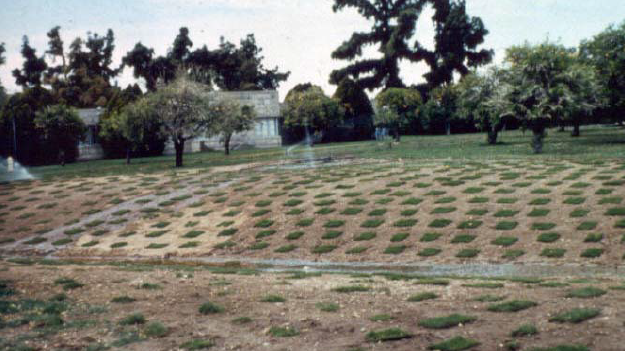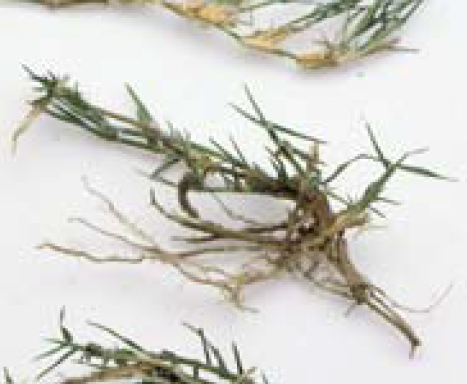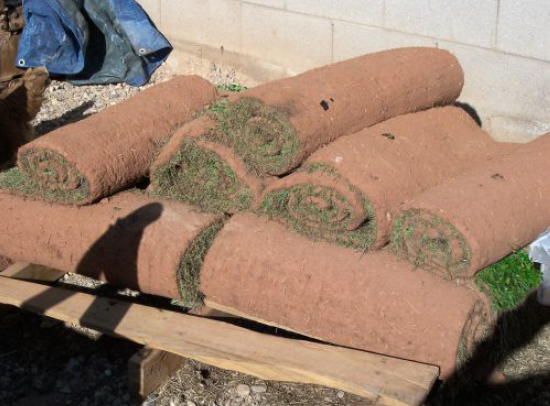Introduction
Lawns can be established through several methods. These include plugging, sprigging, sodding or seeding. The method that you choose will probably depend upon the availability of the turfgrass that you desire and your budget. Plugging and sprigging are vegetative or asexual lawn establishment methods because you use some portion of a grass’ vegetation to establish a lawn identical to the mother plant. Seeding and sod established from seed are not vegetative methods since seed is sexual by its nature -- derived from a grass’ flowers or inflorescence. Finding a wide selection of lawn grasses was a problem in the past but many excellent selections are now available through online “stores”.
Vegetative Lawn Establishment
Plugs
One method of vegetative lawn establishment is plugging. Currently, plugs are not available locally but can be purchased online. Plugs can be viewed as a small stand of turfgrass, frequently accompanied with soil, held together by their own rhizomes (underground stems) or stolons (aboveground stems). Make your own plugs by cutting sod into small pieces, anywhere from 2 to 12 inches square or purchase plugs grown in plastic trays, grown much like bedding plants. Space them evenly through the planting area. The further apart they are the longer it takes to establish a finished lawn. Generally plugs are planted 12 inches apart into prepared soil (Figure 1).
Turfgrass plugs establish a lawn through the horizontal growth of their rhizomes or stolons. The time needed to establish a lawn from plugs also depends on the type of grass. Fast-growing grasses such as bermudagrass can, if managed properly, establish quickly from plugs. Slower-growing grasses like zoysiagrass establish slower. Plugs of slow-growing turfgrasses require closer spacing for rapid lawn establishment. Frequent watering and the application of high nitrogen fertilizers can maximize the growth of rhizomes and stolons and hasten lawn establishment. Weeds and weeding can be a significant problem when plugging but are reduced by establishing the lawn as rapidly as possible.

Figure 1. Bermudagrass plugs cut from sod.
Sprigs
Sprigs are pieces of stems, stolons or rhizomes that contain two to four nodes (the place on a stem where leaves and roots are attached). Sprigs can be made by chopping a sod which grows by rhizomes or stolons into stem pieces about 2 to 4 inches in length and removing the soil. Each of these “sprigs” can grow roots and stems if the piece contains at least one node. Each node has the potential to produce a complete new grass plant.
Sprigging may also be called stolonizing. Distribute sprigs or stolons, over the surface of a prepared soil and either press them into the soil so the nodes stay protected or cover them with a light layer of soil called topdressing and keep them moist. Fresh, or green, sprigs root more quickly than dried sprigs and some grasses will not establish easily from dried or brown sprigs. Bermudagrasses establish from both but more quickly if they are green. The major reason for poor or spotty establishment from sprigs is failure to keep soil in contact with the sprigs moist during rooting. Normal rates for planting are approximately 10 bushels of sprigs per 1,000 square feet (Figure 2).

Figure 2. Bermudagrass sprigs ready for rooting.
Non-Vegetative Lawn Establishment: Seeding and Sodding
Establish tall fescue, Kentucky bluegrass or ryegrasses either by seed or sod. Of the cool-season grasses suitable for residential landscapes, tall fescue tolerates our desert summer heat the best and can easily be established from seed. Common bermudagrass is also typically established from seed. But common bermudagrass cannot be planted in Clark County, Nev., due to allergies from its pollen production. Seeding rates vary among different grasses but you’ll find seeding rates on the seed bag.
Sod
The most common lawn establishment method, and the most expensive, is by sod. Sod is a solid stand of turfgrass plants held together through mechanical means (Figure 3). Sod grown from grasses which develop stolons or rhizomes rely on these horizontal stems to hold the sod together. These interwoven rhizomes and stolons “knit” individual plants into a “carpet” that does not fall apart when handled. Rhizomes and stolons have nodes or swollen parts of the stem which have the potential for growing roots and stems. These types of grasses are called sod-forming grasses and include the bermudagrasses, Kentucky bluegrass, zoysiagrass, buffalograss, St Augustine grass, and seashore paspalum.
Sod is also available containing grasses which do not develop stolons or rhizomes. These grasses are called bunchgrasses. Two common bunchgrasses which do not develop stolons or rhizomes are tall fescue and ryegrasses. Sod made from bunchgrasses must either include a sod forming grass in the mixture or a plastic mesh to hold the bunchgrasses together. Plastic meshes are frequently used in tall fescue sod for this purpose. A pallet of sod normally covers 500 square feet and weighs about 1800 pounds.

Figure 3. Rolls of tall fescue sod ready for installation.
The Importance of Soil Preparation, Timing and a Well-Designed Irrigation System
Soil preparation
Regardless of the lawn establishment method, the soil preparation is basically the same. A healthy lawn capable of withstanding insects and diseases and capable of rapid recovery, particularly in the desert, requires adequate soil preparation prior to planting. Not providing adequate soil preparation will result in additional maintenance costs and possible lawn failure in the future. Never add or layer coarse textured sands or heavy clays to existing soils.
Use and amend the existing soil if possible. If additional soil must be brought in, then make sure the imported soil is as similar to the existing soil texture as possible. Apply a starter fertilizer high in phosphorus to the surface at a rate of 1 pound or more of phosphorus per 1,000 square feet prior to soil preparation. Next apply a 2-to 3-inch layer of compost to the surface and cultivate this soil to a depth of 10 to 12 inches. Remove any rocks 4 inches in diameter or larger. Stop cultivating when the largest soil clods are golf ball sized. Do not over cultivate or you will ruin the soil’s structure which is important for good root development. Rocks that might interfere with mowing should be removed from the surface.
A very important step after soil cultivation is to roll the future lawn area to firm the soil but not compact it. After firming the soil, foot impressions should not sink more than ½ inch into the prepared soil. At this point you are ready to seed, sod, sprig or plug the planting area.
Timing
Warm season grasses, as their name suggests, establish best during the warm spring and early hot summer months. They need enough time after planting to become established before fall. Establish warm-season grasses from seed or sprigs from April through June. Sod establishment from warm season grasses extends the season an additional month to the beginning of August. Warm-season grasses should not be overseeded for winter color the first year after planting.
On the other hand, cool-season grasses prefer the cooler spring and fall months to get established; February through March and mid-September through mid-October. Cool-season grasses can be established from sod nearly any time of the year but is best if the hottest summer months (June, July and August) and coldest winter months (December and January) are avoided. During the hotter summer months, lay sod in the early morning hours when the soil is cool and water immediately after planting.
Irrigation
In the desert, a lawn is only as good as its irrigation system. A well-designed, properly installed and adequately maintained irrigation system will impact the quality of a lawn’s appearance and health as well as serve as a foundation for efficient water use. Design and install the irrigation system precisely according to manufacturer’s specifications for operating pressure and flow. Water pressures must be either increased (booster pump) or decreased (pressure regulator) to meet the manufacturer’s specifications. All aboveground sprinklers should be designed for head-to-head coverage (non windy locations) and maximum uniformity. Popup sprinklers should have enough clearance above the lawn so that growth of the grass does not interfere with the application of water.
Steps for Sodding, Plugging, Sprigging and Seeding
- Bring soil up to grade. Soils should be similar in texture.
- Prepare soil with organic amendments and starter fertilizer.
- Cultivate to a depth of 12 inches and stop when soil clods are golf ball sized or smaller.
- Roll soil prior to planting. Footprints should sink less than ½ inch deep. a. Seed at rates recommended on the label. Topdress. b. Or sprig at 10 bushels per 1000 square feet. Topdress. c. Or plug at the most 12 inches apart. d. Lay the sod so there are no gaps between pieces.
- Water immediately after planting a. Roll sod or seedbed.
- Irrigate appropriately to keep sod, plugs, sprigs and seed from drying out. This may require irrigating several times each day to keep seed hydrated during germination or rooting. Irrigations will be less frequent after germination and after roots have begun developing.
The Southern Nevada Water Authority allows you to water as much as needed during the first month of establishment.
References
Beard, James B. 1973. Turfgrass: Science and Culture. Prentice Hall. Englewood Cliffs, N.J. 658 pgs.
Devitt, D., R. Morris and D. Bowman.1990. Response of tall fescue to composted sewage sludge used as a soil amendment. Journal of Plant Nutrition. Volume 13(9)1115 – 1139.
Devitt D.A., R.L. Morris and D.C. Bowman. 1992. Evapotranspiration, crop coefficients, and leaching fractions of irrigated desert turfgrass systems. Agronomy Journal 84:717-723.
University of California. UC IPM online. IPM Accessed on September 10, 2010.
Morris, B. and Devitt, D.
2011,
Lawn Establishment in the Mojave Desert,
Extension, University of Nevada, Reno, FS-11-54


